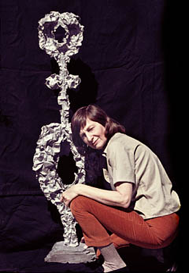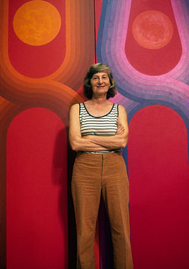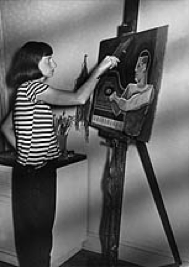Amalie Rothschild was a painter, sculptor and printmaker who lived and worked her entire life in Baltimore, Maryland and made enormous contributions to the cultural and artistic environment of the city and local area. Born Amalie Getta Rosenfeld on January 1, 1916, she was an artist all her life, starting to draw and study from the age of six. Even after her marriage at age 20 and the birth of two daughters, she had the drive and discipline to spend at least six hours a day in her studio, five to six days a week, until the day she went into the hospital for cancer surgery in August 2000. She died the next year, on November 4, 2001. Rothschild worked in many media, was immensely curious, and experimented with many forms and materials. Local recognition began with her first solo exhibition at the Baltimore Museum of Art in 1942 and continued until the end of her life. She showed her work in New York from time to time, most notably during the 1960s, but, for many reasons, including her commitment to her husband and family, she chose not to promote her career beyond the Baltimore–Washington, D.C. mid-Atlantic region. When she died she left a vast oeuvre comprising approximately 1400 fully realized works in all media, some 270 of which are in private collections and museums.
Rothschild is best known as an abstract, geometric painter and sculptor working in materials including plexiglas, aluminum, bronze, bark, handmade cast paper, and particle board, as well as oil and acrylic, watercolor and drawing. She studied illustration and fashion design at the Maryland Institute College of Art in Baltimore and after graduating with honors in 1934 had a six month scholarship at Parson’s in New York City. Her recently widowed mother did not allow her to continue her studies in Paris, where she had been offered a fellowship, so she returned to Baltimore in 1935. There she began her career as a painter of regional genre scenes and later progressed to a more complex and sophisticated examination of form. Her work, despite its abstract geometric appearance, was frequently self-referential and often dealt with the issues of balancing the duties of wife and mother with the strivings of the artist, while at the same time paying homage to historical themes.
During the 1960s Rothschild broke out from her often hard-edged geometric paintings into sculpture and created more than 325 works, from large outdoor and sometimes monumental pieces, to elegant, table-top scale spatial explorations of balance that examined the contrast between the solid and the void, to linear pieces that have been described as "drawing in space."
Beginning in the feminist 1970’s Amalie Rothschild created her most innovative work, a series she referred to as Vestments. Although the title suggests ecclesiastical attire, the works are also imbued with armorial imagery. Constructed of sculptural materials, including aluminum and translucent plexiglas, which simulate colorful evocations of stained glass, as well as cord and handmade chain links, the non-wearable forms are designed to hang and be seen from front and back, more in the manner of textiles than sculptures. In them she introduced new ways to think about the possibilities of artistic production and sculptural ideas. The Vestments emphasize shape and form rather than mass and address issues of both identity and form. They even seem to be emblems of protective clothing for women warriors in the battle to create a new art.
Rothschild's fascination with technique led her to acquire the many necessary skills to fabricate all her work herself in her studio-machine shop, and she became a superb craftsperson, calling on experts to help her learn new techniques.
Throughout her life she drew almost every day, creating hundreds of works on paper. But she returned often to painting and was a major force in the Maryland art world. Rothschild founded the Baltimore Outdoor Art Festival (1952-68), co-founded Gallery One in 1959 (the first co-operative artists’ gallery in Baltimore), co-founded Maryland Art Place, was a President of Maryland Artist’s Union, served on the Boards of the Baltimore Museum of Art and the Maryland Institute College of Art, taught at Goucher College and the Metropolitan School of Art, supported younger artists including establishing a sculpture materials Prize for graduate students at the Rinehart School of Sculpture, and gave generously of her time to the community while never losing sight of commitment to her own development and dedication as a full-time artist.


